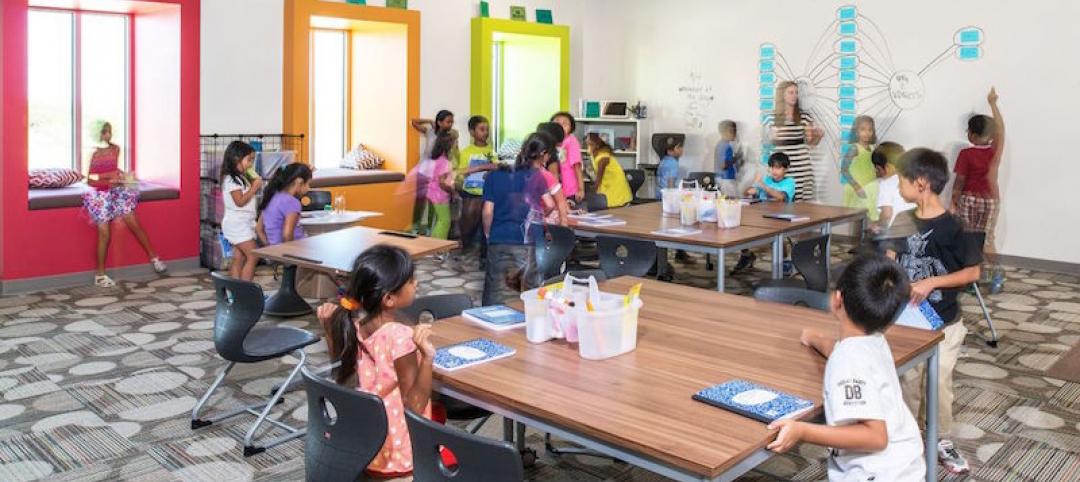As more students enter the school system each year, designing for fire safety in educational facilities has never been more critical. Fire-rated glazing can be a key part of the solution. With proper specification, it can defend against the spread of fire, resist impact from rambunctious students and transfer natural light into learning areas, which can improve student performance.1
A case in point is the design and development of an egress stairwell in Concord, New Hampshire's Mill Brook Elementary School. To support the school’s vision for developing a multi-use “learning corridor” that brings education beyond the classroom, HMFH Architects designed the fire-rated stairwell to be bright and open, reflecting the playful energy of students. They achieved this goal by pairing Fireframes® Aluminum Series fire-resistant frames with Pilkington Pyrostop® fire-resistant glass, both supplied by Technical Glass Products (TGP).
Rather than the bulky, wrap-around frames often associated with traditional fire-rated framing systems, the Fireframes Aluminum Series fire-rated frames have slender profiles that can be custom wet painted, anodized or powder coated in nearly any color. In this application, the narrow fire-rated frames were powder coated a bright purple to match the interior color scheme—a key aesthetic benefit since learning areas are integrated into public spaces outside student classrooms.
Pilkington Pyrostop fire-resistant glazing allowed the design team to incorporate unrestricted amounts of transparent glazing in the stairwell to improve light transfer. The product also offers fire-ratings of up to two hours, and blocks the transfer of radiant heat, providing essential protection should students need to exit the building during a fire. Pilkington Pyrostop meets the impact requirements of CPSC 16CFR1201 Category I and/or Category II – a critical performance benefit for glass used in busy stairwells.
TGP’s Fireframes Aluminum Series fire-rated frames with Pilkington Pyrostop transparent fire-rated glazing also proved beneficial during the renovation of Johnson & Wales University Center for Physician Assistant Studies. The building’s lack of openness and accessibility to the street was a concern for DBVW Architects during the design phase. “The original main entrance to the building was not handicap accessible and not as grand as we envisioned for Johnson & Wales’ new Physician Assistant Program,” explains Sean Redfern, associate principle for DBVW Architects.

Bright purple fire-rated egress stairwell at Mill Brook Elementary School
For the lobby and stairs to satisfy building codes and successfully work together to create a clear circulation path for students and faculty entering the school, DBVW Architects paired the Fireframes Aluminum Series fire-rated frames with Pilkington Pyrostop transparent fire-rated glazing.
“Together, the thin profile design of TGP’s Fireframes Aluminum Series fire-rated frames and clear Pilkington Pyrostop fire-rated glass helped us achieve the transparency and fire protection we were looking for in the space,” explains Sean Redfern, associate principle for DBVW Architects. “Using fire rated glass for an entire exit stair enclosure isn’t something you see every day. But the openness that TGP’s fire-rated frames and glass created fit well with our design aspirations.”
For more information on how to select first-class glass solutions that can support fire and life safety protection and student wellbeing goals in schools, please visit fireglass.com.
1Sapna Cheryan, Sianna A. Ziegler, Victoria C. Plaut, and Andrew N. Meltzoff. Designing Classrooms to Maximize Student Achievement. Policy Insights from the Behavioral and Brain Sciences, 2014
Windows and Classrooms: A Study of Student Performance and the Indoor Environment, a 2003 study conducted by the Heschong Mahone Group.
Technical Glass Products
800.426.0279
800.451.9857 – fax
sales@fireglass.com
www.fireglass.com
Related Stories
K-12 Schools | May 31, 2017
NAC Architecture rolls out ‘Hack Your Classroom’ campaign
In collaboration with room2learn, NAC launched a campaign aimed at crowd-sourcing information on what teachers are doing in their classroom to improve the learning experience.
K-12 Schools | May 16, 2017
The future of schools: Net zero should be the norm
Students are helping drive change by focusing on the future.
K-12 Schools | May 1, 2017
Seattle’s first vertically-oriented middle school breaks ground
The building will provide 74,289 sf of space across its five-story classroom bar.
K-12 Schools | Apr 21, 2017
The stadium effect
School districts that invested in their athletic facilities over the last few years have seen a tremendous increase in student morale and health, growth in campus culture, and excitement within their communities.
K-12 Schools | Apr 7, 2017
Is an alternative project delivery method right for your K-12 school district?
With California’s increasingly busy—and costly—construction market, it’s becoming more difficult to predict costs with a typical design-bid-build delivery method.
K-12 Schools | Mar 9, 2017
The future of education facilities: Creating spaces where learning happens everywhere
The art of designing schools lies not in just understanding what makes a functional classroom, but in how successful we are in creating a wide array of educational options for teachers and students within the school environment.
K-12 Schools | Mar 9, 2017
School branding: The impact on identity and engagement
What is school branding and why is it important? HMC Architects’ James Krueger and Barbara Perez weigh in on the topic.
K-12 Schools | Feb 22, 2017
Through the principal's eyes: A look at K-12 architecture
Anderson-Livsey is a K-5 school located about 30 minutes East of Atlanta in Gwinnett County and has an enrollment of 785 students.
K-12 Schools | Feb 8, 2017
'Fabrication Hall' introduces Wyoming high school students to career paths
The hall offers bountiful natural light with enough space to build large-scale projects.
Architects | Jan 19, 2017
Harley Ellis Devereaux merges with Deems Lewis McKinley
The combination is expected to bolster HED’s presence in northern California and the K-12 sector.

















